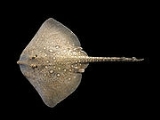
Thornback ray
Encyclopedia
The thornback ray or thornback skate is a species of fish
in the Rajidae family. It is found in coast
al waters of Europe
and the Atlantic coast of Africa
, possibly as far south as Namibia
and even South Africa
. Its natural habitat
s are open sea
s and shallow seas. It is sometimes seen trapped in large estuarine
pools at low tide.
In sexually mature fish some of the spines are thickened with button-like bases (known as bucklers). These are particularly well developed on the tail and back of sexually mature females. The colour varies from light brown to grey with darker blotches and numerous small darker spots and yellow patches. Sometimes the yellow patches are surrounded by small dark spots. The underside is creamy-white with a greyish margin.
s, particularly amphipods and bottom-living shrimp
s - adults feed on crab
s, shrimps and small fish.
Fish
Fish are a paraphyletic group of organisms that consist of all gill-bearing aquatic vertebrate animals that lack limbs with digits. Included in this definition are the living hagfish, lampreys, and cartilaginous and bony fish, as well as various extinct related groups...
in the Rajidae family. It is found in coast
Coast
A coastline or seashore is the area where land meets the sea or ocean. A precise line that can be called a coastline cannot be determined due to the dynamic nature of tides. The term "coastal zone" can be used instead, which is a spatial zone where interaction of the sea and land processes occurs...
al waters of Europe
Europe
Europe is, by convention, one of the world's seven continents. Comprising the westernmost peninsula of Eurasia, Europe is generally 'divided' from Asia to its east by the watershed divides of the Ural and Caucasus Mountains, the Ural River, the Caspian and Black Seas, and the waterways connecting...
and the Atlantic coast of Africa
Africa
Africa is the world's second largest and second most populous continent, after Asia. At about 30.2 million km² including adjacent islands, it covers 6% of the Earth's total surface area and 20.4% of the total land area...
, possibly as far south as Namibia
Namibia
Namibia, officially the Republic of Namibia , is a country in southern Africa whose western border is the Atlantic Ocean. It shares land borders with Angola and Zambia to the north, Botswana to the east and South Africa to the south and east. It gained independence from South Africa on 21 March...
and even South Africa
South Africa
The Republic of South Africa is a country in southern Africa. Located at the southern tip of Africa, it is divided into nine provinces, with of coastline on the Atlantic and Indian oceans...
. Its natural habitat
Habitat
* Habitat , a place where a species lives and grows*Human habitat, a place where humans live, work or play** Space habitat, a space station intended as a permanent settlement...
s are open sea
Sea
A sea generally refers to a large body of salt water, but the term is used in other contexts as well. Most commonly, it means a large expanse of saline water connected with an ocean, and is commonly used as a synonym for ocean...
s and shallow seas. It is sometimes seen trapped in large estuarine
Estuary
An estuary is a partly enclosed coastal body of water with one or more rivers or streams flowing into it, and with a free connection to the open sea....
pools at low tide.
Description
The thornback ray is probably one of the most common rays encountered by divers. Like all rays it has a flattened body with broad, wing-like pectoral fins. The body is kite-shaped with a long, thorny tail. The back is covered in numerous thorny spines, as is the underside in older females. Adult fish can grow to 1 m (3.3 ft) in length although most are less than 85 cm (33.67 in). This ray can weigh from 4.5 to 8.75 lb (2 to 3.98 kg).In sexually mature fish some of the spines are thickened with button-like bases (known as bucklers). These are particularly well developed on the tail and back of sexually mature females. The colour varies from light brown to grey with darker blotches and numerous small darker spots and yellow patches. Sometimes the yellow patches are surrounded by small dark spots. The underside is creamy-white with a greyish margin.
Habitat
The thornback ray is usually found on sediment type seabeds such as mud, sand or gravel at depths between 10–60 m. Juvenile fish feed on small crustaceanCrustacean
Crustaceans form a very large group of arthropods, usually treated as a subphylum, which includes such familiar animals as crabs, lobsters, crayfish, shrimp, krill and barnacles. The 50,000 described species range in size from Stygotantulus stocki at , to the Japanese spider crab with a leg span...
s, particularly amphipods and bottom-living shrimp
Shrimp
Shrimp are swimming, decapod crustaceans classified in the infraorder Caridea, found widely around the world in both fresh and salt water. Adult shrimp are filter feeding benthic animals living close to the bottom. They can live in schools and can swim rapidly backwards. Shrimp are an important...
s - adults feed on crab
Crab
True crabs are decapod crustaceans of the infraorder Brachyura, which typically have a very short projecting "tail" , or where the reduced abdomen is entirely hidden under the thorax...
s, shrimps and small fish.

